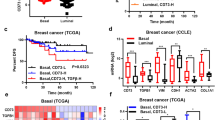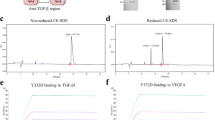Abstract
TGF-β contributes to drug resistance and the invasiveness of tumor cells and weakens the anti-tumor immune responses. The present study aimed at examining the efficacy of the combination of SB431542, as a specific inhibitor of TGF-βR, and doxorubicin in controlling the melanoma tumor in mice. The impact of the combination of the doxorubicin and SB431542 on the cell growth, apoptosis, migration, and invasiveness of B16-F10 cells was examined. Besides, the B16-F10 tumor was induced in C57BL/6 mice, and the effects of the mentioned treatment on the tumor volume, survival, and the exhaustion state of T cells were evaluated. Although the combination of doxorubicin and SB431542 did not exhibit synergism in the inhibition of cell growth and apoptosis induction, it efficiently prohibited the migration and the epithelial to mesenchymal transition of B16-F10 cells, and the combination of doxorubicin and SB431542 caused an increase in mRNA levels of E-cadherin and, on the other hand, led to a decline in the expression of Vimentin. Tumor volume and the survival of tumor-bearing mice were efficiently controlled by the combination therapy. This treatment also eventuated in a decrease in the percentage of PD-L1+, TCD4+, and TCD8+ cells as indicators of exhausted T cells within the spleens of tumor-bearing mice. Blockade of TGF-βR also propelled the RAW 264.7 cells towards an anti-tumor M1 macrophage phenotype. The inhibition of TGF-βR demonstrated a potential to increase the efficacy of doxorubicin chemotherapy by the means of affecting cellular motility and restoring the anti-tumor immune responses.







Similar content being viewed by others
Data availability
The data supporting the findings of this study are provided as supplementary files.
Change history
19 September 2021
The affiliation 4 contained mistake where two “s” have been missed in “System” and “Poisoning” words. This has been updated and correctly captured as "Chemical Injuries Research Center, Systems Biology and Poisonings Institute, Baqiyatallah University of Medical Sciences, Tehran, Iran".
Abbreviations
- TGF-β:
-
Transforming growth factor-β
- EMT:
-
Epithelial to mesenchymal transition
- Tregs:
-
Regulatory T cells
- APCs:
-
Antigen-presenting cells
- TGF-βR:
-
Receptor of TGF-β
- GAPDH:
-
Glyceraldehyde 3-phosphate dehydrogenase
- MDSCs:
-
Myeloid-derived suppressor cells
- ALK-5:
-
Activin receptor-like kinase-5
References
Blank CU, Haining WN, Held W et al (2019) Defining ‘T cell exhaustion.’ Nat Rev Immunol 19:665–674
Brabletz T, Kalluri R, Nieto MA, Weinberg RA (2018) EMT in cancer. Nat Rev Cancer 18:128–134
Chen N-T, Wu C-Y, Chung C-Y et al (2012) Probing the dynamics of doxorubicin-DNA intercalation during the initial activation of apoptosis by fluorescence lifetime imaging microscopy (FLIM). PLoS One 7:e44947
Christowitz C, Davis T, Isaacs A et al (2019) Mechanisms of doxorubicin-induced drug resistance and drug resistant tumour growth in a murine breast tumour model. BMC Cancer 19:757
Demir EA, Demir S, Aliyazicioglu Y (2020) In vitro cytotoxic effect of ethanol and dimethyl sulfoxide on various human cell lines. KSU J Agric Nat 23:1119–1124
Diskin B, Adam S, Cassini MF et al (2020) PD-L1 engagement on T cells promotes self-tolerance and suppression of neighboring macrophages and effector T cells in cancer. Nat Immunol 21:442–454
Domingues B, Lopes JM, Soares P, Pópulo H (2018) Melanoma treatment in review. Immunotargets Ther 7:35
Fang R, Zhang G, Guo Q et al (2013) Nodal promotes aggressive phenotype via snail-mediated epithelial–mesenchymal transition in murine melanoma. Cancer Lett 333:66–75
Franco F, Jaccard A, Romero P et al (2020) Metabolic and epigenetic regulation of T-cell exhaustion. Nat Metab 2:1001–1012
Furukawa F (2019) The Nobel Prize in Physiology or Medicine 2018 was awarded to cancer therapy by inhibition of negative immune regulation. Trends Immunother 2:1–2
Fuxe J, Karlsson MCI (2012) TGF-β-induced epithelial-mesenchymal transition: a link between cancer and inflammation. Semin Cancer Biol 22:455–461
Gass J, Donald M (1985) Comparison of uveal melanoma growth rates with mitotic index and mortality. Arch Ophthalmol 103:924–931
Gibbons Johnson RM, Dong H (2017) Functional expression of programmed death-ligand 1 (B7–H1) by immune cells and tumor cells. Front Immunol 8:961
Gonda TA, Tu S, Wang TC (2009) Chronic inflammation, the tumor microenvironment and carcinogenesis. Cell Cycle 8:2005–2013
Gowrishankar K, Birtwistle L, Micklethwaite K (2018) Manipulating the tumor microenvironment by adoptive cell transfer of CAR T-cells. Mamm Genome 29:739–756
Hargadon KM, Johnson CE, Williams CJ (2018) Immune checkpoint blockade therapy for cancer: an overview of FDA-approved immune checkpoint inhibitors. Int Immunopharmacol 62:29–39
Heldin C-H, Vanlandewijck M, Moustakas A (2012) Regulation of EMT by TGF$β$ in cancer. FEBS Lett 586:1959–1970
Ianevski A, Giri AK, Aittokallio T (2020) SynergyFinder 2.0: visual analytics of multi-drug combination synergies. Nucleic Acids Res 48:W488–W493
Lamouille S, Xu J, Derynck R (2014) Molecular mechanisms of epithelial–mesenchymal transition. Nat Rev Mol Cell Biol 15:178–196
Lee MK, Pardoux C, Hall MC et al (2007) TGF-$β$ activates Erk MAP kinase signalling through direct phosphorylation of ShcA. EMBO J 26:3957–3967
Lee YS, Choi H, Cho H-R et al (2021) Downregulation of NKG2DLs by TGF-$β$ in human lung cancer cells. BMC Immunol 22:1–13
Leonardi GC, Falzone L, Salemi R et al (2018) Cutaneous melanoma: from pathogenesis to therapy. Int J Oncol 52:1071–1080
Liu M, Li S, Li MO (2018) TGF-$β$ Control of adaptive immune tolerance: a break from Treg cells. BioEssays 40:1800063
Liu Y, Liang S, Jiang D et al (2021) Manipulation of TAMs functions to facilitate the immune therapy effects of immune checkpoint antibodies. J Control Release 336:621–634
Mardomi A, Sabzichi M, Somi MH et al (2016) Trafficking mechanism of bone marrow-derived mesenchymal stem cells toward hepatocellular carcinoma HepG2 cells by modulating Endoglin, CXCR4 and TGF-β. Cell Mol Biol (Noisy Le Gd Fr) 62:81–86
Mellor HR, Callaghan R (2008) Resistance to chemotherapy in cancer: a complex and integrated cellular response. Pharmacology 81:275–300
Mhaidly R, Mechta-Grigoriou F (2020) Fibroblast heterogeneity in tumor micro-environment: role in immunosuppression and new therapies. Semin Immunol 48:101417
Mokhtari RB, Homayouni TS, Baluch N et al (2017) Combination Therapy in Combating Cancer Oncotarget 8:38022
Moo-Young TA, Larson JW, Belt BA et al (2009) Tumor derived TGF-Beta mediates conversion of CD4+ Foxp3+ regulatory T cells in a murine model of pancreas cancer. J Immunother (Hagerstown, Md 1997) 32:12–21
O’Neill RE, Cao X (2019) Co-stimulatory and co-inhibitory pathways in cancer immunotherapy. Adv Cancer Res 143:145–194
Pan J-X, Chen G, Li J-J et al (2018) Isocorydine suppresses doxorubicin-induced epithelial-mesenchymal transition via inhibition of ERK signaling pathways in hepatocellular carcinoma. Am J Cancer Res 8:154
Perica K, Varela JC, Oelke M, Schneck J (2015) Adoptive T cell immunotherapy for cancer. Rambam Maimonides Med J 6:e0004
Premkumar K, Shankar BS (2020) TGF-βR inhibitor SB431542 restores immune suppression induced by regulatory B–T cell axis and decreases tumour burden in murine fibrosarcoma. Cancer Immunol Immunother 70:153–168
Raghavan R, Cheriyamundath S, Madassery J (2015) Dimethyl sulfoxide inactivates the anticancer effect of cisplatin against human myelogenous leukemia cell lines in in vitro assays. Indian J Pharmacol 47:322
dos Reis ST, Pontes-Júnior J, Antunes AA et al (2011) Tgf-β1 expression as a biomarker of poor prognosis in prostate cancer. Clinics 66:1143–1147
Renu K, Abilash VG, TirupathiPichiah PB, Arunachalam S (2018) Molecular mechanism of doxorubicin-induced cardiomyopathy–an update. Eur J Pharmacol 818:241–253
Salmaninejad A, Valilou SF, Shabgah AG et al (2019) PD-1/PD-L1 pathway: basic biology and role in cancer immunotherapy. J Cell Physiol 234:16824–16837
Sheng W, Liu Y, Chakraborty D et al (2021) Simultaneous inhibition of LSD1 and TGF-B enables eradication of poorly immunogenic tumors with anti-PD-1 treatment. Cancer Discov 11:1970–1981
Shi Y, Moon M, Dawood S et al (2011) Mechanisms and management of doxorubicin cardiotoxicity. Herz 36:296–305
Stone EL, Lim YW, Coles GL et al (2021) Single cell transcriptomics reveals the effect of PD-L1 and TGF-B blockade on the tumor microenvironment. Cancer Res 81:2684
Sun Y (2016) Tumor microenvironment and cancer therapy resistance. Cancer Lett 380:205–215
Taefehshokr N, Baradaran B, Baghbanzadeh A, Taefehshokr S (2020) Promising approaches in cancer immunotherapy. Immunobiology 225:151875
Tanaka R, Umemura M, Narikawa M et al (2020) Reactive fibrosis precedes doxorubicin-induced heart failure through sterile inflammation. ESC Hear Fail 7:588–603
Tauriello DVF, Batlle E (2018) TGFβ drives immune evasion in genetically reconstituted colon cancer metastasis. ESMO Open 3:A4. https://doi.org/10.1136/esmoopen-2018-EACR25.8
Tunçer S, Gurbanov R, Sheraj I et al (2018) Low dose dimethyl sulfoxide driven gross molecular changes have the potential to interfere with various cellular processes. Sci Rep 8:1–15
Twomey JD, Zhang B (2021) Cancer immunotherapy update: FDA-Approved checkpoint inhibitors and companion diagnostics. AAPS J 23:1–11
Wang D, DuBois RN (2015) Immunosuppression associated with chronic inflammation in the tumor microenvironment. Carcinogenesis 36:1085–1093
Wang J, Li D, Cang H, Guo B (2019) Crosstalk between cancer and immune cells: role of tumor-associated macrophages in the tumor microenvironment. Cancer Med 8:4709–4721
Wang Y, Ma Y, Fang Y et al (2012) Regulatory T cell: a protection for tumour cells. J Cell Mol Med 16:425–436
Xu A, Liu Y, Chen W et al (2016) TGF-$β$–induced regulatory T cells directly suppress B cell responses through a noncytotoxic mechanism. J Immunol 196:3631–3641
Yang F, Teves SS, Kemp CJ, Henikoff S (2014) Doxorubicin, DNA torsion, and chromatin dynamics. Biochim Biophys Acta (BBA)-Reviews Cancer 1845:84–89
Yang L, Pang Y, Moses HL (2010) TGF-$β$ and immune cells: an important regulatory axis in the tumor microenvironment and progression. Trends Immunol 31:220–227
Zhang F, Wang H, Wang X et al (2016) TGF-$β$ induces M2-like macrophage polarization via SNAIL-mediated suppression of a pro-inflammatory phenotype. Oncotarget 7:52294
Zhang Q, Chang X, Wang H et al (2019) TGF-β1 mediated Smad signaling pathway and EMT in hepatic fibrosis induced by Nano NiO in vivo and in vitro. Environ Toxicol 35:419–429
Zhang Y, Li Y, Chen K et al (2021) Oncolytic virotherapy reverses the immunosuppressive tumor microenvironment and its potential in combination with immunotherapy. Cancer Cell Int 21:1–17
Zhou H, Liu M, Deng T et al (2019) The TGF-$β$/Smad pathway inhibitor SB431542 enhances the antitumor effect of radiofrequency ablation on bladder cancer cells. Onco Targets Ther 12:7809
Funding
No funding information is available for this study.
Author information
Authors and Affiliations
Contributions
AM: conceptualization and practical experiments; MG and MK: data analysis and manuscript drafting; MP, MS, and MPK: collaboration in cell culture and animal model studies; AS: study design, management, and critical revision of the manuscript. All data were generated in-house and no paper mill was used.
Corresponding author
Ethics declarations
Ethics approval
This study was conducted under ethical approvals from the local ethics committee (registration code: IR. BMSU.REC.1399.98000536) and in accordance with the NIH Guide to Laboratory Animal Care.
Consent to participate
All authors agree to participate in this study.
Consent for publication
All authors agree to publish.
Competing interests
The authors declare no competing interests.
Additional information
Publisher's note
Springer Nature remains neutral with regard to jurisdictional claims in published maps and institutional affiliations.
Supplementary Information
Below is the link to the electronic supplementary material.
Rights and permissions
About this article
Cite this article
Mardomi, A., Ghollasi, M., Korani, M. et al. Blockade of TGF-βR improves the efficacy of doxorubicin by modulating the tumor cell motility and affecting the immune cells in a melanoma model. Naunyn-Schmiedeberg's Arch Pharmacol 394, 2309–2322 (2021). https://doi.org/10.1007/s00210-021-02134-x
Received:
Accepted:
Published:
Issue Date:
DOI: https://doi.org/10.1007/s00210-021-02134-x




